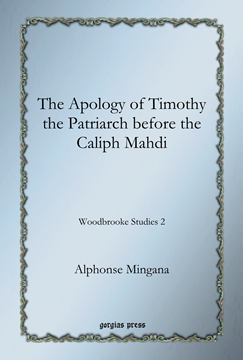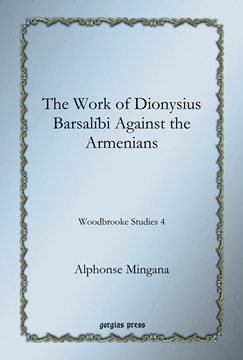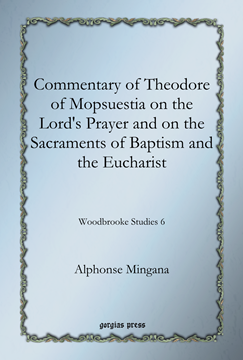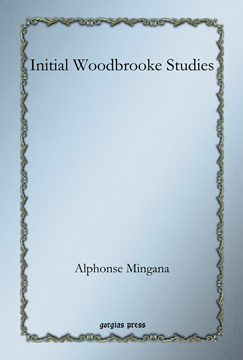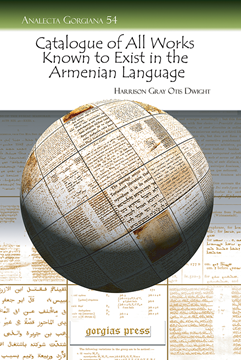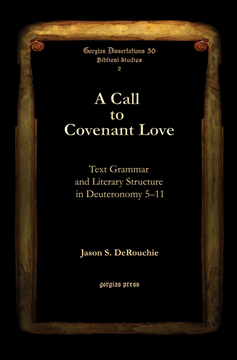The Apology of Timothy the Patriarch before the Caliph Mahdi
Woodbrooke Studies 2
ISBN: 978-1-59333-827-5
Part of Alphonse Mingana’s “Woodbrooke Studies” (of which the present book is volume 2), The Apology of Timothy the Patriarch before the Caliph Mahdi is accompanied in this volume by The Lament of the Virgin and The Martyrdom of Pilate. The namesake of the volume, Timothy’s apology for Christianity, is an eighth-century manuscript and one of the earliest documents concerning Christianity’s relationship with Islam. The Lament of the Virgin is Mary’s sadness at the empty tomb; in this piece she is conflated with Mary Magdalene. The Martyrdom of Pilate presents Pontius Pilate as a saint and lays out his spiritual accomplishments that are crowned by his martyrdom.
$167.00 (USD) $100.20 (USD)
A Syriac Valentinian Hymn
An Excerpt from Epiphanius' Panarion
Series: Analecta Gorgiana 52
ISBN: 978-1-59333-867-1
Epiphanius, the great fourth century heresiographer, included in his discussion of the Valentinians an excerpt from a manuscript, of which Newbold here provides the Greek text and the Syriac original, along with his translation, textual notes and commentary.
$90.00 (USD) $54.00 (USD)
Commentary of Theodore of Mopsuestia on the Nicene Creed
Woodbrooke Studies 5
ISBN: 978-1-59333-828-2
The Commentary of Theodore of Mopsuestia on the Nicene Creed is an important document of an instrumental age in the development of Christianity. Theodore (c. 350-428) was clearly the most important biblical scholar of his age. While his theology eventually led to his loss of favor among some branches of the church, Theodore was at least partially responsible for three church councils held to deal with his ideas, including those of Ephesus and Chalcedon. Mingana has published here, as Woodbrooke Studies 5, for the first time a document that had previously been lost and which contains Theodore’s observations on the outcome of the Council of Nicaea, the Nicene Creed.
$145.00 (USD) $87.00 (USD)
The Work of Dionysius Barsalībi Against the Armenians
Woodbrooke Studies 4
ISBN: 978-1-59333-829-9
The Work of Dionysius Barsalībi Against the Armenians represents the nature of some disputes in the Christianity of the Middle Ages. Dionysius Barsalībi (d. 1171) in a very rare manuscript, begins by giving a brief sketch of the political and religious history of the Armenians. Dionysius argues that Christ’s body was corruptible up until the time of his death, and only after that did it become incorruptible. This underscores the fact that Christ had a true human body and that he digested food just like other people. The implications for this interpretation in connection with the Eucharist are obviously essential aspects to be resolved in this controversy.
$118.00 (USD) $70.80 (USD)
Commentary of Theodore of Mopsuestia on the Lord's Prayer and on the Sacraments of Baptism and the E
Woodbrooke Studies 6
ISBN: 978-1-59333-830-5
The Commentary of Theodore of Mopsuestia on the Lord’s Prayer and on the Sacraments of Baptism and the Eucharist is an important witness to the development of Christianity. Theodore (c. 350-428) was clearly the most important biblical scholar of his age. In a series of six homilies Theodore here addresses the Lord’s Prayer as a springboard to discuss what actually constitutes prayer. His homilies on the sacraments are essential witnesses to the historical development of these sacraments. His work here is basically a commentary on the text of the liturgy, an awareness of the centrality of the sacraments to the life of the church in his age.
$155.00 (USD) $93.00 (USD)
Initial Woodbrooke Studies
Woodbrooke Studies 1
ISBN: 978-1-59333-832-9
The initial installments of Alphonse Mingana’s “Woodbrooke Studies: Christian Documents in Syriac, Arabic, and Garshūni, edited and translated with a critical apparatus,” began as articles within the Bulletin of the John Rylands Library Manchester, starting in volume 11. In this initial foray into publishing the manuscripts in his personal collection, Mingana offers translations and critical comments on seven documents: A Treatise of Barsalībi against the Melchites; Genuine and Apocryphal Works of Ignatius of Antioch; A New Jeremiah Apocryphon; A New Life of John the Baptist; Some Uncanonical Psalms; the Vision of Theophilus; and the Apocalypse of Peter.
$188.00 (USD) $112.80 (USD)
Ascetic Strains in Early Judaism
Series: Analecta Gorgiana 53
ISBN: 978-1-59333-868-8
Reviewing the relevant Jewish and Christian literature the author demonstrates that though there is no mandate for ascetic practice within early Judaism, there is a deep respect there for an ascetic way of life.
$41.00 (USD) $24.60 (USD)
Das Sendschreiben des Patriarchen Barschuschan an den Catholicus der Armenier
The Circular Letter of the Patriarch Bar Shushan to the Catholicos of Armenia
By Otto Lichti
Series: Analecta Gorgiana 50
ISBN: 978-1-59333-865-7
This work provides the Syriac text, with a German introduction and translation, of John Bar Shushan’s treatise attacking the Melkite tradition, upholding the Creed of Faith, defending the Syrian Orthodox preparation of the Eucharist, and criticizing Armenian Church practices.
$48.00 (USD) $28.80 (USD)
Catalogue of All Works Known to Exist in the Armenian Language
Up to the Seventeenth Century
Series: Analecta Gorgiana 54
ISBN: 978-1-59333-869-5
This work provides a summary, short author biography, and reference to editions or translations of all the works of Armenian provenance known to the author. It concludes with works of Greek Church Fathers and secular literature preserved in Armenian.
$90.00 (USD) $54.00 (USD)
A Call to Covenant Love
Text Grammar and Literary Structure in Deuteronomy 5–11
Series: Gorgias Biblical Studies 30
ISBN: 978-1-59333-674-5
Profound in its conclusions and targeted toward the exegete, this volume offers a clear method for establishing flow of thought, text hierarchy, and literary macrostructure in biblical Hebrew prose. The study contributes both to hermeneutical theory and to the study of Deuteronomy by arguing for the application of discourse linguistics alongside stylistic and semantic analysis in the interpretation of OT texts. It includes a brief literary-structural and theological commentary on Deuteronomy 5–11 that models the text grammatical approach and shows its benefits for exegesis.
$189.00 (USD) $113.40 (USD)
